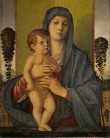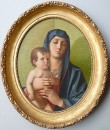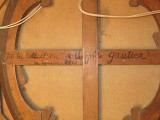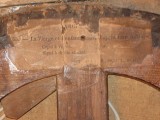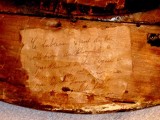The browser will either open the file, download it, or display a dialog.

A Nineteenth-Century Copy of Giovanni Bellini’s Madonna degli alberetti from the Collection of Théophile Gautier
A painting that once belonged to Théophile Gautier has recently been rediscovered in Italy. It is a nineteenth-century copy of the Madonna degli alberetti (Madonna of the Small Trees) by Giovanni Bellini (fig. 1) in the Accademia Gallery in Venice.[1] The copy, now in the collection of Elvio Mich in Trent, Italy (fig. 2),[2] is listed in the catalogue of the sale of Gautier’s collection at the Hôtel Drouot on January 14–16, 1873 (n. 35).[3] Its location, until recently, was unknown, and it has never been published. The rediscovered copy allows us to identify with certainty that the Madonna degli alberetti was in fact the painting that Gautier admired during his visits to the Accademia in 1850, confirming Marie-Hélène Girard’s hypothesis to that effect in her edition of Gautier’s 1852 travelogue, Italia: Voyage en Italie.[4]
An Admired Original
Gautier’s chapters on his visits to the Accademia are a well-known part of Italia. At the end of chapter 19, he writes:
Let’s finish with the jewel, the pearl, the star of this museum: A Madonna with Christ Child by Giovanni Bellini. — Here is a well-worn subject, beaten to death, treated thousands of times, yet which blossoms with eternal youth under the brush of the old master! What is there? A woman holds a child on her knees, but what a woman. This head pursues you as if in a dream, and whoever has seen it once will see it forever; she exhibits an impossible beauty, and yet, a strange truth; [a sense of] immaculate virginity and penetrating voluptuousness; supreme disdain [couched] in infinite sweetness. Standing before the canvas, I thought I was contemplating the portrait of a secret dream, discovered by surprise in my soul by the artist. Every day, I went to spend an hour at the feet of this celestial idol and I would never have been able to leave Venice if a young French painter, taking pity on me, had not made a copy of this much-cherished head.[5]
In this passage, Gautier reiterates some of his favorite themes and ideas: the ability of great artists to treat subjects worn out by tradition in new and original ways; the feeling of déjà vu that a work of art may generate in the beholder as it gives concrete form to an interior image; and the contradictory nature of beauty, defined here as an opposition between “immaculate virginity” and “penetrating voluptuousness,” as well as between disdain and sweetness. All of these elements recall Gautier’s novel Mademoiselle de Maupin (1835–36) and its hero, d’Albert, who questions himself on the origins of the woman of his dreams:
Who gave me the idea of this imaginary woman? From what clay have I molded this invisible statue? From where did I take the feathers that I attached to the back of this chimera? What mystical bird deposited into a dark corner of my soul the overlooked seed from which my dream is born?[6]
D’Albert wonders if his ideal was inspired by a painting:
What school did the painting belong to from which this beauty emerged white and shining in the middle of black shadows? Was it Raphael who caressed the contour that pleases you? Was it Cleomenes who polished the marble that you adore? Are you in love with a Madonna or a Diana?[7]
Before recognizing his ideal incarnated in Mademoiselle de Maupin, d’Albert dreams of a woman, “blond with black eyes,” a pictorial synthesis of the vivacity of Rubens and the elegance of Giorgione: “A beauty of a character both fine and firm at the same time, elegant and vivacious, poetic and real, a motif of Giorgione executed by Rubens.”[8] In front of the Accademia canvas, Gautier may have first been inspired by a vision of idealized feminine beauty that would later serve him in his articulation of his literary character Mademoiselle de Maupin.
The Copyist
Gautier did not reveal, in Italia, the identity of the painter who made the copy of Bellini’s Madonna, but the sales catalogue of 1873 documented the painting as the work of Louis-Marius Garcin, who is mentioned in another chapter of the travelogue in connection with another copy after an old master:
A young French painter, Louis-Marius Garcin, was in the middle of making a copy of this beautiful painting [The Presentation of the Ring to the Doge of Venice by Paris Bordone] that we hope to see soon in Paris.[9]
Garcin (1821–98), a student of Michel Martin Drolling and Ary Scheffer, specialized, according to Emmanuel Bénézite, in “history painting, figure compositions, genre scenes, portraits, animated landscapes, seascapes, [and] animals.”[10] Garcin exhibited at the Salons from 1848 through 1864, and the Musée Municipal of Hyères, France, the town in which he was born and died, holds several of his paintings.
Gautier mentioned Garcin’s painting Vue prise aux îles d’Hyères in his review of the Salon of 1853, published in La Presse on July 23, 1853, but had more to say about another of Garcin's works, inspired by Bocaccio’s Decameron, that was exhibited at the World’s Fair of 1855. After describing the work as a “group of young men and beautiful women” fleeing the plague-bound city of Florence, he wrote:
Mr. Garcin has a fine-tuned and lively sense of the Italian Middle Ages, so elegant, so graceful, so different from our own. One can see from his manner that he has studied the delicious frescos by Benozzo Gozzoli at the Palazzo Ricardo [sic] with love. We reproach him, however, for a rather dry gracility and for the paleness of his tones, which look more like egg tempera than oil painting. Perhaps this defect, if it is one, is voluntary, and the artist wanted to characterize the period by recalling the techniques of the masters of the day. This painting, executed with a rare care and conscientiousness, reveals a good deal of progress on Mr. Garcin’s part.[11]
The references to Benozzo Gozzoli and to the frescoes of the chapel of the Palazzo Medici Riccardi suggest that Gautier thought Garcin was especially interested in Quattrocento painting. Whether or not he knew this before Garcin copied the Bellini is not clear. Gautier’s allusive remark in chapter 19 of Italia about Garcin “taking pity” on him by making the copy also leaves vague the exact nature of the sale: did Gautier commission Garcin, or did Garcin specialize in quattrocento copies from which Gautier may have selected the Bellini?
The Copy
Garcin’s copy of Bellini’s Madonna is an oil painting on canvas, measuring 57 x 46 cm. The copy, with its oval format, crops the original by excluding the trees in the background and the Christ child’s feet. Several inscriptions and labels on the stretcher allow some hypotheses about the painting’s history. A sprawling black ink inscription on the main support bar of the stretcher no doubt dates from the Gautier auction at Drouot’s: “De la collection de Théophile Gautier / 14 janvier 1873” (fig. 3). A small label also relates to this sale: “GARCIN / 35. La Vierge et l’enfant Jésus, d’après Jean Bellin. / Copié à Venise. Signé à droite et daté. / T. ... – H., 0m, 57. L., 0m, 46” (fig. 4) .[12] On the bottom right of the frame is an inscription written directly on the wood in ink: “M. Jules Frayssinet de Beaumont de Lomagne.” This is the name of a member of the Archaelogical Society of Tarn-et-Garonne, author of several books on local topics published in 1878 and 1879. Was he the first purchaser of the painting at the 1873 auction? A final inscription can be read on a label glued to the stretcher: “Ce tableau vient de la / collection de Théophile / Gauthier [sic] et a été légué à / mon père Meur Long ... par Mme Long ... / ... petite fille / ...” (fig. 5).[13] These labels suggest that the work stayed in private hands after the initial public auction. Its value may have stemmed more from its provenance as a piece of a cherished French author’s collection than its appearance. While nineteenth-century copies such as this have generally not held much market value, they can interest us today as records of nineteenth-century cultural practices including tourism, early museum-going, reproductive techniques, and the interaction between painting and literature.
The Museum of Copies
The practice of copying interested Gautier more generally. At least three other copies were listed in the 1873 auction of his collection, two after Velasquez, and one after an anonymous Italian master.[14] More than just collecting them for himself, however, Gautier clearly thought copies had a place in the public eye. In chapter 17 of Italia, after having described the painting by Paris Bordone that Garcin was copying, Gautier evoked the idea of a museum of copies:
It seems to us that a museum composed of well-done copies after the masterpieces of all the schools would be something very interesting and beneficial to art. Many elements for such a gallery must already exist. A room could be dedicated to each great master; all his works, currently dispersed in the museums and churches of Europe, would be copied; a choice would be made among the lesser masters [maîtres de second ordre], if they are original, witty, and, though lacking in genius, yet full of talent. And that which is disseminated over all the earth and which requires, to be seen, long and costly voyages, often impossible, would be reunited in this palace.[15]
Gautier was certainly familiar with the common nineteenth-century practice of making architectural and sculptural casts after famous works of art. These were used primarily by fine arts students as part of their training in art academies, and were even exhibited to the public shortly after the Revolution in Alexandre Lenoir’s Musée des monuments français, which opened in 1795.[16] Gautier might also have been thinking of the Musée des Etudes at the Ecole des Beaux-Arts, where, as early as the 1830s, young artists came to draw from these copies of works that their professors deemed the finest examples and thus best suited to develop their budding talents. In 1871, Charles Blanc began working on an idea for an ultimately short-lived Musée des Copies that would also include paintings; it opened to the general public in April, 1873 but closed due to political wrangling in December of that year.[17] Gautier and Blanc met in 1842 and subsequently knew each other well.[18] They were on good terms until Gautier’s death in 1872, and it is not known to what extent Gautier may have contributed to Blanc’s ideas.
Gautier’s purchase of Garcin’s copy of the Bellini Madonna degli alberetti and his proposition for a museum of copies, articulated in the 1850s, seem to stem, then, from several of his ongoing interests: the training of painters through the practice of copying; the project of a pedagogical museum, devoted to developing public taste; and a desire for a utopian synthesis of the arts, that appeared in texts of a different nature, from Fortunio (1837; with its diorama allowing viewers to see all the cities of the world)[19] to Paris futur (1851; with its “hybrid temple” reuniting all the world’s architecture from all times).[20] While we will never know for certain, perhaps Gautier would have been pleased to have his copy after Bellini figure in Charles Blanc’s Musée des Copies.
Paolo Tortonese
Director, Centre de Recherche sur les Poétiques du XIXe siècle,
Université Paris 3
Translated from the French by Pamela J. Warner and Petra Chu
[1] Bellini’s original had entered into the collections of the Accademia in 1838 as a gift from Girolamo Contarini. See M. Lucco and Giovanni C. F. Villa, Giovanni Bellini, exh. cat., Scuderie del Quirinale, Rome, (Cinisello Balsamo (Milan): Silvana Editoriale, 2008), 246.
[2] We are grateful to Mr. Mich for allowing us to publish it here.
[3] This catalogue has been republished by Stéphane Guégan in Theophile Gautier, la critique en liberté (Paris: Réunion des Musées Nationaux, 1997); see page 160.
[4] Théophile Gautier, Italia:Voyage en Italie, ed. Marie-Hélène Girard (Paris: La Boîte à Documents, 1997), 470.
[5] “Terminons par le joyau, la perle, l’étoile de ce musée : Une Madone avec l’enfant Jésus, de Jean Bellin. – Voilà un sujet bien usé, bien rebattu, traité mille fois, et qui refleurit d’une jeunesse éternelle sous le pinceau du vieux maître ! Qu’y a-t-il ? Une femme qui tient un enfant sur ses genoux, mais quelle femme ! Cette tête vous poursuit comme un rêve, et qui l’a vue une fois la voit toujours ; c’est une beauté impossible, et cependant d’une vérité étrange, d’une virginité immaculée et d’une volupté pénétrante ; un dédain suprême dans une douceur infinie. Il nous semblait, devant cette toile, contempler le portrait de notre rêve inavoué, surpris dans notre âme par l’artiste. Chaque jour, nous allions passer une heure aux pieds de cette céleste idole, et nous n’aurions jamais pu partir de Venise si un jeune peintre français, nous prenant en pitié, ne nous avait fait une copie de cette tête si chère.” Gautier, Italia, 209–10.
[6] “Qui nous a donné l’idée de cette femme imaginaire ? de quelle argile avons-nous pétri cette statue invisible ? où avons-nous pris les plumes que nous avons attachées au dos de cette chimère ? quel oiseau mystique a déposé dans un coin obscur de notre âme l’œuf inaperçu dont notre rêve est éclos?” Théophile Gautier, Oeuvres, choix de romans et de contes, ed. Paolo Tortonese (Paris: Laffont, 1995), 220.
[7] “À quelle école appartenait le tableau où cette beauté ressortait blanche et rayonnante au milieu des noires ombres ? Est-ce Raphaël qui a caressé le contour qui vous plaît ? est-ce Cléomène qui a poli le marbre que vous adorez ? – êtes-vous amoureux d’une madone ou d’une Diane?” Ibid., 221.
[8] “Un caractère de beauté fin et ferme à la fois, élégant et vivace, poétique et réel ; un motif de Giorgione exécuté par Rubens.” Ibid., 215.
[9] “Un jeune peintre français, Louis-Marius Garcin, était en train de faire de cette belle toile [Paris Bordone (1500–1571), La Remise de l’anneau au Doge] une copie que nous espérons bientôt voir à Paris.” Gautier, Italia, 193.
[10] Emmanuel Bénézit, Dictionnaire critique et documentaire des peintres, sculpteurs, dessinateurs et graveurs, rev. ed. (Paris: Gründ, 1999), 5:865.
[11] “Il y a chez M. Garcin un sentiment très-vif et très-fin du moyen âge italien, si élégant, si gracieux, si différent du nôtre. On voit à sa manière qu’il a étudié avec amour les délicieuses fresques de Benozzo Gozzoli au palais Ricardo. Nous lui reprocherons cependant une gracilité un peu sèche et une pâleur de ton qui sent plus la peinture à l’eau d’œuf que le peinture à l’huile. Peut-être ce défaut, si c’en est un, est-il volontaire, et l’artiste a-t-il voulu caractériser l’époque en rappelant les procédés des peintres du temps. Ce tableau, exécuté avec un soin et une conscience rares, accuse un grand progrès chez M. Garcin.” Théophile Gautier, Les Beaux-arts en Europe (Paris: Michel Lévy, 1857), 2:111–12. The painting was held from 1858 by the Musée d’Art in Toulon, under the title Le Décameron ou Départ de la société du Décameron de la place de Sainte-Marie-Nouvelle pendant la peste de Florence en 1348, but it was destroyed during World War II. I would like to thank Brigitte Gaillard, curator of the Musée d’Art of Toulon, for giving me this information. See also entry no. 53 in Charles Ginoux, Notice des tableaux, sculptures et autres objets d’art exposés dans les galeries du Musée-Bibliothèque (Toulon: Lieutaud et Cie., 1900), 20.
[12] “Garcin. 35. Virign and Christ child, after Giovanni Bellini. Copied in Venice. Signed to the right and dated.”
[13] “This painting comes from the collection of Théophile Gautier and was left to my father, Mr. Long ... by Mrs. Long ... grand daughter. ....”
[14] They are listed there as: “n°77. Porion, La Reddition de Breda : Las Lanzas. Esquisse : copie d’après Vélasquez; n°78. Porion, Les Buveurs : Los Borrachos. Esquisse : copie d’après Vélasquez. n°162. O’Connel (Mme Frédérique), Copie d’après un maître italien, aquarelle.” See Guégan, Theophile Gautier, la critique en liberté. The “Arcade” database of the French Ministry of Culture reports that one of the Velasquez copies, executed by French painter Charles Porion, was made upon commission for 3500 francs, but they do not say if Gautier was the patron or if he acquired it later. See http://www.culture.gouv.fr/public/mistral/arcade_fr?ACTION=CHERCHER&FIELD_1=REF&VALUE_1=AR313223 (accessed July 28, 2011).
[15] “Il nous semble qu’un musée composé de copies bien faites des chefs-d’œuvre de toutes les écoles serait une chose très intéressante et fort profitable pour l’art. Il doit exister déjà beaucoup d’éléments d’une telle galerie. On consacrerait une salle à chaque grand maître dont on copierait l’œuvre tout entière éparpillée dans les musées et les églises d’Europe ; on ferait un choix parmi les maîtres de second ordre, si originaux, si spirituels, et, à défaut de génie, si pleins de talent. Et l’on réunirait dans ce palais ce qui est disséminé sur toute la terre et exige, pour être vu, de longs et coûteux voyages, souvent impossibles.” Gautier, Italia, 193.
[16] On the origins of the numerous plaster copy museums that emerged in the nineteenth-century, see Jean-Luc Martinez, "Les moulages en plâtre d'après l'antique du musée du Louvre : Une utopie du XIXe siècle," in D'après l'antique, Musée du Louvre, exh. cat. (Paris: RMN, 2000) 78–82; and Christine Pinatel, "Origine de la collection des moulages d'antiques de l'Ecole nationale des Beaux-Arts de Paris, aujourd'hui à Versailles," in L'Anticomanie: La collection d'antiquités aux 18e et 19e siècles (Paris: Ecole des Hautes Etudes en Sciences Sociales, 1992), 307–25.
[17] See Albert Boime, “Le Musée des copies,” Gazette des Beaux-Arts 63, no. 1(October 1964), 237–47.
[18] See Marie-Hélène Girard’s comments in Gautier’s Correspondance générale, 1849–1851, ed. Claudine Lacoste-Veysseyre (Geneva: Droz, 1989), 4:447–48. The very few letters exchanged between the two make no reference to Blanc’s Musée des Copies.
[19] In Gautier, Oeuvres complètes, 568–69.
[20] Théophile Gautier, “Paris futur,” Le Pays, December 20–21, 1851.


